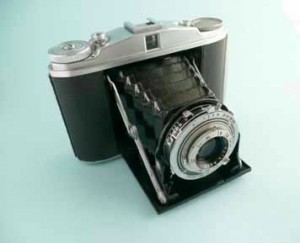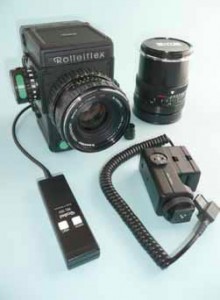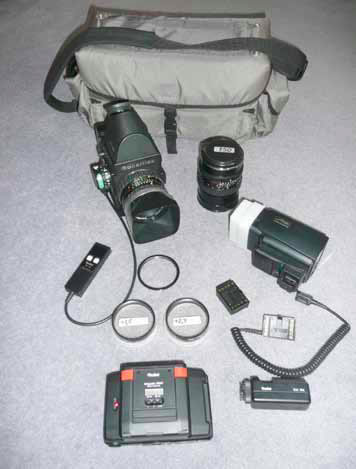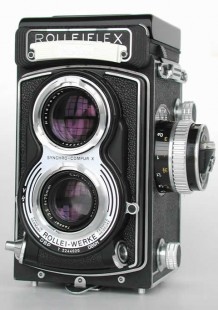The article by Ken Williams (CRU Issue 19 - Rollei 6008AF vs Bronica ETR-Si by Ken Williams) was very interesting to me as I do own and use both of the above camera outfits, but in my case it was the other way round as I started off with the Bronica and then added the Rollei. I thought people might be interested in hearing about a similar way of doing photography.
For over three decades I took all the family and holiday pictures with an Agfa Isolette II (Photo 1.), which gave me good results and was sufficient for prints up to A4.
After migrating to Australia in 1982 I was so overwhelmed by the new subjects to photograph that the Isolette did not offer enough features for all the different shots I wanted to take, especially with its limitations to getting very close to all those wonderful flowers in my new country.
So, against better advice I bought a complete second-hand Rollei SL 2000 kit, which should have done all the jobs I had in mind with the wide range of accessories available. However, the best I achieved between repairs was two-and-a-half rolls of film, and then the camera was away for several weeks. After three of such episodes I had had enough.
Another reason to swap systems was that, from an artistical point of view, I found the configuration of the miniature format too narrow and restricting. I always wanted to show a bit more in my composition. To get a better idea of what to expect I put a slide film into the old Agfa and felt that this was the way to go in the future, despite the mediocre results with that camera.
Rollei gear was out of reach for me at that time (1988), as I too am just an enthusiastic amateur. Therefore, I tried a Pentacon six TL, a 6 × 6 camera from East Germany. Here too there was nothing but trouble: poor film flatness, overlapping frames and bad electrical contacts.
So the search began for something more reliable and not too heavy to carry around. In 1988 three firms built systems for the 6 × 4½ format: Pentax, Mamiya and Bronica. The Pentax was the most automated but did not offer exchangeable magazines; Mamiya had the widest range of accessories but focal plane shutters and a long-winded process for the two leaf-shutter lenses. At that time there was also no TTL flash, which I thought I would use quite often. So, I decided on the just-released Bronica ETRSi; it had TTL flash, leaf-shutter lenses of very good quality and a magazine for 24 × 54 mm panorama. Over the years I bought more and more into the system, mostly second-hand, and changed over gradually to those great PE lenses – except for the 40 mm one, which I felt was already very sharp.
My experience with the ETRSi system up to date has been a positive one: it has never let me down and produces consistantly excellent results.
In 1989 we went back to Germany for a visit and I took with me the Rollei SL 2000 and Pentacon six TL to trade in for a new Bronica ETRSi kit. The dealer laughed at me for suggesting such a deal and pointed at six SL 2000s and four Pentacon sixes he had already sitting on his used-camera shelf. Only my determination of ‘no trade-in, no purchase’ made him come around and offer a lousy 600 deutschmarks for both.
I only do slides, though for my private and public presentations I did want to mix in a few 6 × 6 images to fill the screen when I thought this format to be more suited to the subject. Hence, a used Bronica ECTL was added to the equipment and did a good job, except for not-always perfect film flatness. Other than that it was a good system, if an old one with no chance of repairs or spares should the electronic shutter be faulty. I did like the built-in light meter, which few medium-format cameras from 1975 had.
Some years ago when every farmer and his dog started switching to digital cameras, the prices of second-hand Rollei gear crashed and it became more affordable to switch to a sophisticated camera system like the Rolleiflex 6008, which I purchased and fell in love with instantly. So the ECTL went and a 6008i took its place.
Now I put together my photographic outfit according to what I am going to photograph. Whenever possible, I prefer a photorucksack to a shoulder bag, 7 especially for travelling and bushwalking. For such trips the Bronica gear becomes my main tool due to the lesser weight and that goes into the rucksack (Main Photo). At the same time my kind wife would carry the bare (WLF, no handgrip) 6008i plus a 50 mm lens and TTL flash adapter in the bottom part of her rucksack (Photo 3).
But for visits to flower shows or gardens, for example, I would pack a basic Rollei kit into a shoulder bag and might even include the 6 × 4½ magazine. The one flash serves both systems and I also carry a set of 67 mm filters for them, plus the 62 mm Nikon achromatic close-up lenses I have written about before. All lenses on both systems are fitted with the needed step-up or step-down rings (Photo 4). I do agree with Ken Williams; even when the slides are projected onto a 2 × 2 m screen, I cannot see a difference in quality between the Rollei and Bronica lenses when the slides are mixed together in a set.
In another article I will tell you about the way I do my slide shows and the preparation that goes into them.




